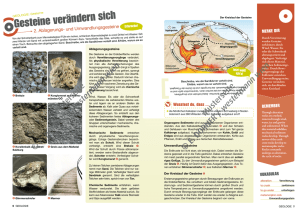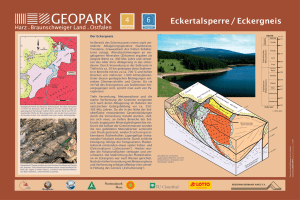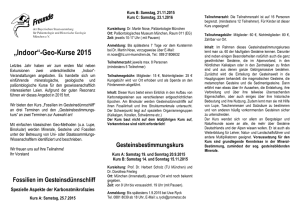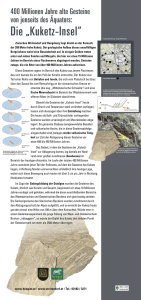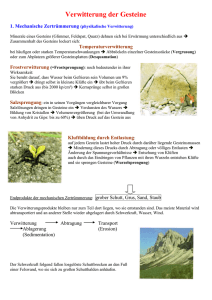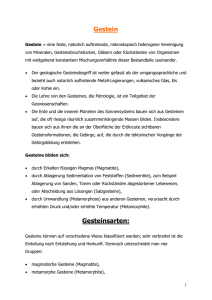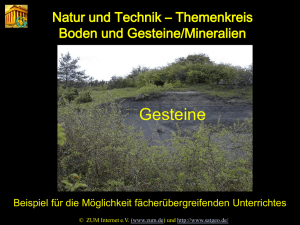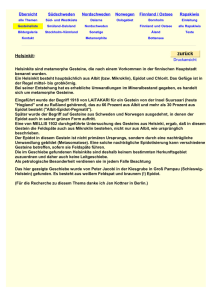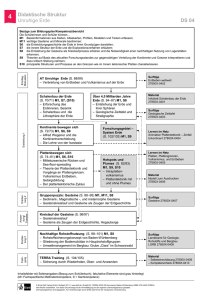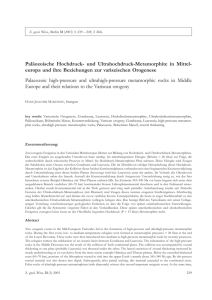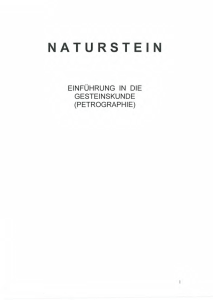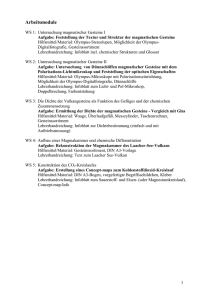und Magerungsrohstoffe in Deutschland (Teil 1)
Werbung
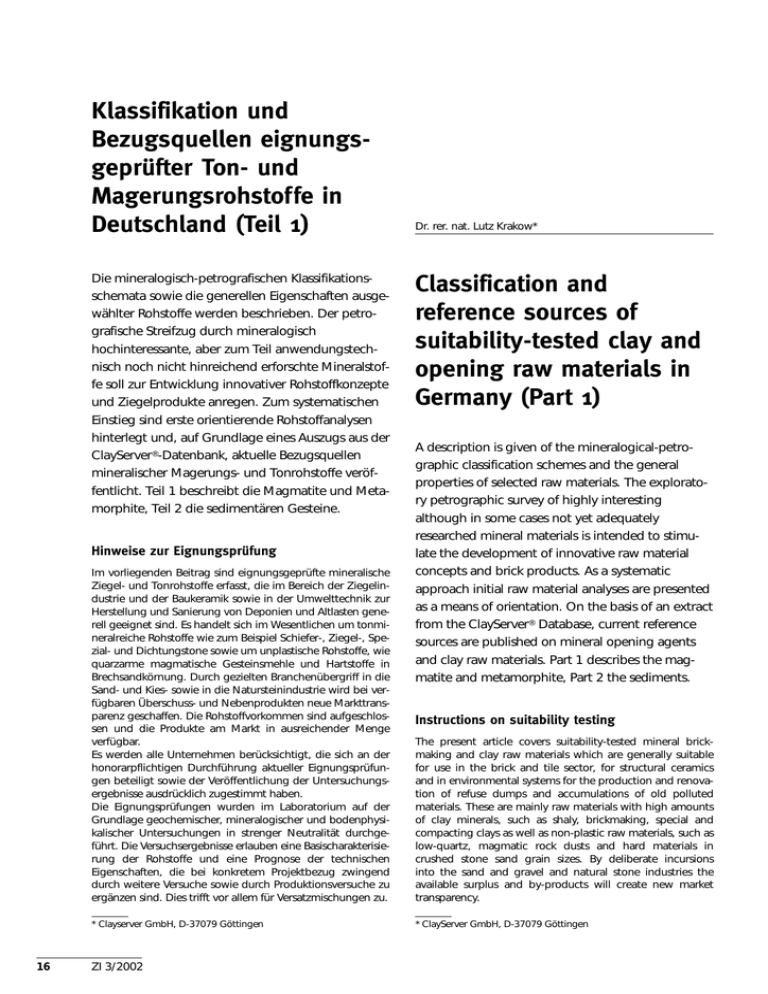
Klassifikation und Bezugsquellen eignungsgeprüfter Ton- und Magerungsrohstoffe in Deutschland (Teil 1) Die mineralogisch-petrografischen Klassifikationsschemata sowie die generellen Eigenschaften ausgewählter Rohstoffe werden beschrieben. Der petrografische Streifzug durch mineralogisch hochinteressante, aber zum Teil anwendungstechnisch noch nicht hinreichend erforschte Mineralstoffe soll zur Entwicklung innovativer Rohstoffkonzepte und Ziegelprodukte anregen. Zum systematischen Einstieg sind erste orientierende Rohstoffanalysen hinterlegt und, auf Grundlage eines Auszugs aus der ClayServer®-Datenbank, aktuelle Bezugsquellen mineralischer Magerungs- und Tonrohstoffe veröffentlicht. Teil 1 beschreibt die Magmatite und Metamorphite, Teil 2 die sedimentären Gesteine. Hinweise zur Eignungsprüfung Im vorliegenden Beitrag sind eignungsgeprüfte mineralische Ziegel- und Tonrohstoffe erfasst, die im Bereich der Ziegelindustrie und der Baukeramik sowie in der Umwelttechnik zur Herstellung und Sanierung von Deponien und Altlasten generell geeignet sind. Es handelt sich im Wesentlichen um tonmineralreiche Rohstoffe wie zum Beispiel Schiefer-, Ziegel-, Spezial- und Dichtungstone sowie um unplastische Rohstoffe, wie quarzarme magmatische Gesteinsmehle und Hartstoffe in Brechsandkörnung. Durch gezielten Branchenübergriff in die Sand- und Kies- sowie in die Natursteinindustrie wird bei verfügbaren Überschuss- und Nebenprodukten neue Markttransparenz geschaffen. Die Rohstoffvorkommen sind aufgeschlossen und die Produkte am Markt in ausreichender Menge verfügbar. Es werden alle Unternehmen berücksichtigt, die sich an der honorarpflichtigen Durchführung aktueller Eignungsprüfungen beteiligt sowie der Veröffentlichung der Untersuchungsergebnisse ausdrücklich zugestimmt haben. Die Eignungsprüfungen wurden im Laboratorium auf der Grundlage geochemischer, mineralogischer und bodenphysikalischer Untersuchungen in strenger Neutralität durchgeführt. Die Versuchsergebnisse erlauben eine Basischarakterisierung der Rohstoffe und eine Prognose der technischen Eigenschaften, die bei konkretem Projektbezug zwingend durch weitere Versuche sowie durch Produktionsversuche zu ergänzen sind. Dies trifft vor allem für Versatzmischungen zu. * Clayserver GmbH, D-37079 Göttingen 16 ZI 3/2002 Dr. rer. nat. Lutz Krakow* Classification and reference sources of suitability-tested clay and opening raw materials in Germany (Part 1) A description is given of the mineralogical-petrographic classification schemes and the general properties of selected raw materials. The exploratory petrographic survey of highly interesting although in some cases not yet adequately researched mineral materials is intended to stimulate the development of innovative raw material concepts and brick products. As a systematic approach initial raw material analyses are presented as a means of orientation. On the basis of an extract from the ClayServer® Database, current reference sources are published on mineral opening agents and clay raw materials. Part 1 describes the magmatite and metamorphite, Part 2 the sediments. Instructions on suitability testing The present article covers suitability-tested mineral brickmaking and clay raw materials which are generally suitable for use in the brick and tile sector, for structural ceramics and in environmental systems for the production and renovation of refuse dumps and accumulations of old polluted materials. These are mainly raw materials with high amounts of clay minerals, such as shaly, brickmaking, special and compacting clays as well as non-plastic raw materials, such as low-quartz, magmatic rock dusts and hard materials in crushed stone sand grain sizes. By deliberate incursions into the sand and gravel and natural stone industries the available surplus and by-products will create new market transparency. * ClayServer GmbH, D-37079 Göttingen Klassifikation und Petrografie der Rohstoffe Natürliche mineralische Rohstoffe werden nach den gesteinsbildenden Prozessen und ihrer geologischen Entstehung in Magmatite (Eruptivgesteine), Metamorphite (Versenkungsgesteine) und Sedimente (Ablagerungsgesteine) gegliedert. Schätzwerte über die Häufigkeit der Gesteine im Bereich der oberen kontinentalen Erdkruste bis 25 km Tiefe belaufen sich wie folgt [1]: n magmatische Gesteine: 65 Vol.-% n metamorphe Gesteine: 27 Vol.-% n sedimentäre Gesteine: 8 Vol.-% Von dieser Häufigkeitsverteilung unterscheidet sich der Befund an der oberflächennahen Erdkruste, wie er in Deutschland oder auch anderen Teilen Mitteleuropas zu beobachten ist, grundlegend. Hier dominiert mengenmäßig klar die Gruppe der verfestigten und unverfestigten Sedimentgesteine, die unter anderem die typischen Ziegelrohstoffe wie Tone, Schiefertone und Lehme umfasst. Magmatische und metamorphe Gesteine treten in Oberflächennähe nur untergeordnet auf, wobei die Verbreitung in der Regel auf Gebiete südlich der mitteldeutschen Gebirgsschwelle begrenzt ist. Magmatische Gesteine Die magmatischen Gesteine sind Kristallisationsprodukte aus natürlichen, glutheißen, silikatischen Schmelzen. In Abhängigkeit von der Tiefenlage des Kristallisationsortes wird in der Grobeinteilung zunächst zwischen Plutoniten (Tiefengesteinen) und Vulkaniten (Ergussgesteinen) unterschieden. Plutonite kristallisieren in tieferen Erdstockwerken in der Magmenkammer bei langsamer Abkühlung z. B. als Granite aus. Sie weisen überwiegend ein mittel- bis großkörniges Korngefüge ohne Textureffekte auf. Einzelminerale sind in der Regel mit bloßem Auge erkennbar. Demgegenüber sind die Vulkanite durch Aufstieg und Intrusion (Vorgang, bei dem Magma zwischen die Gesteine der Erdkruste eindringt und erstarrt) des Magmas bis in den oberflächennahen Schichtenverband oder durch Ausfließen und Entgasen des Magmas an der Erdoberfläche gekennzeichnet. Infolge der raschen Abkühlung ist das Gefüge der Vulkanite generell feinkörniger als das der Tiefengesteine. Bei der Kristallisation der intrusiven Schmelzen entstehen überwiegend fein- bis mittelkörnige Vulkanite, aus den extrusiven (an der Erdoberfläche erstarrten) Schmelzen vorwiegend klein- bis dichtkörnige Vulkanite wie z. B. Basalte. Bei Abschreckung der Laven, beispielsweise im Kontakt mit Meerwasser, erstarren die Laven häufig auch als vulkanisches Glas. Vulkanische Gesteine weisen oft ein porphyrisches Gefüge auf, bei dem größer entwickelte „Einsprenglinge“ in einer feinkörnigen, zum Teil auch glasigen Grundmasse eingebettet sind. Poröse Laven mit basaltischer Zusammensetzung werden als Lavaschlacken bezeichnet. Die meisten Vulkane fördern neben flüssiger Lava auch festes Material, das explosiv ausgeworfen wird. Diese Lockerstoffe sedimentieren auf der Erdoberfläche als pyroklastische Gesteine. Je nach Korngröße wird zwischen vulkanischen Blöcken, Lapilli und Aschen unterschieden. Die staubfeinen bis sandigen Aschen verfestigen sich unter Wassereinfluss zu Tuffen. Erodierte Aschen und Tuffe, die mit Tonen vermengt und sekundär abgelagert werden, bezeichnet man als Tuffite. Als weitere Gruppe magmatischer Gesteine sind die Subvulkanite (Ganggesteine) zu nennen, die hinsichtlich ihres Kristallisationsortes und ihrer Gefügeeigenschaften eine Zwischenstellung zwischen den Plutoniten und den Vulkaniten The raw material deposits have been developed and the products are available in adequate quantities on the market. All firms are considered who are engaged in carrying out current suitability tests for professional fees and have expressly agreed to publication of the test results. The suitability tests were carried out in the laboratory on the basis of geochemical, mineralogical and soil physics tests in a strictly neutral procedure. The test results permit a basic characterization of the raw materials and a forecast of the technical properties, which it is urgently necessary to supplement by further analyses and product tests in relation to the actual project. This especially applies to backfilling mixes. Classification and petrography of raw materials Natural mineral raw materials are subdivided according to the rock formation processes and their geological origin into magmatite (eruptive rocks), metamorphite (folded or faulttype rocks) and sediments (depositional rocks). Estimated values of the frequency of rocks in the area of the upper continental earth’s crust to a depth of 25 km are as follows [1]: n magmatic rocks 65% by vol. n metamorphic rocks 27% by vol. n sedimentary rocks 8% by vol. The findings basically differ from this frequency distribution in the near-surface earth’s crust, as can be observed in Germany or also other parts of Central Europe. Here the group of consolidated and non-consolidated sedimentary rocks clearly predominate by volume, which include typical brickmaking materials such as clays, shaly clays and loams. Magmatic and metamorphic rocks occur to only a minor extent in near-surface areas, and their distribution is normally limited to regions south of the Central German mountain threshold. Magmatic rocks The magmatic rocks are crystallization products of natural red-hot silicate melts. Depending on the depth of the crystallization areas a rough division is first made between plutonites (deep rocks) and vulcanites (extrusive rocks). Plutonites crystallize in the deeper earth levels in the magma chambers with slower cooling, e.g. as granite. They mainly display a medium to coarse grain structure without textural effects. Individual minerals are usually visible to the naked eye. In contrast to these the vulcanites are characterized by ascent and intrusion (process in which magma penetrates and solidifies between the rocks of the earth’s crust) of the magma up to the near-surface strata system or by the discharge and degassing of the magma on the earth’s surface. As a result of the rapid cooling, the structure of the vulcanite is generally of finer grain size than the deep rocks. In the crystallization of the intrusive melts vulcanites of fine to medium-sized grains mainly occur, from the extrusive melts (solidified on the earth’s surface), the melts are mainly small to dense-grained vulcanites, such as basalts. On the quenching of lavas, for example in contact with seawater, the lavas also frequently solidify as vulcanite glass. Vulcanite rocks often have a porphyritic texture in which the more coarsely developed “intrusive components“ are embedded in a fine-grained, in some cases also glassy groundmass. Porous types of lava of basaltic composition are described as lava slags. Most vulcan materials as well as liquid lava are carriers of solid material, which is ejected explosively. These loose materials form sediments on the earth’s surface as pyroclastic rocks. Depending on the ZI 3/2002 17 Vulkanite Vulcanite Plutonite Bild 1: Klassifikation der magmatischen Gesteine [aus 2] Fig. 1: Classification of the magmatic rocks [from 2] einnehmen. Es handelt sich um Materialien, die im subvulkanischen Niveau als Gänge oder Intrusivkörper erstarrt sind. Die weitergehende Klassifikation der magmatischen Gesteine erfolgt im Wesentlichen nach ihrem modalen Mineralbestand unter Verwendung des QAPF-Doppeldreiecks bzw. des sog. „Streckeisendiagramms“. Wie Bild 1 schematisch zeigt, werden die Gesteine dabei nach ihren unterschiedlichen Gemengteilen an folgenden Mineralen und Mineralgruppen eingeteilt [aus 2]: Felsische beziehungsweise helle Minerale n Q = Quarz n A = Alkalifeldspäte n P = Plagioklas n F = Foide und Feldspatvertreter Mafische beziehungsweise dunkle Minerale n M = Glimmer, Amphibole, Pyroxene, Olivin. 18 ZI 3/2002 Dunit/Dunite Harzburgit/Harzburgite Wehrit/Wehrite Peridodite Lherzolitz Lherzolite Oliving-Orthopyroxenit Olivine orthopyroxenite OlivinKlinopyroxenit Olivine Clinopyroxenite Olivin-Websterit Olivine-Websterite Pyroxenite Websterit/Websterite Klinopyroxenit Clinopyroxenite Orthopyroxenit Orthopyroxenite Anorthosit/Anorthosite (Plagioklasit/Plagioclasite) Anorthosite (Leuco/lightcoloured) Gabbro/Norit Gabbro/Norite Olivin-Gabbro/ Norit Oivine/Gabbro/ Norite Troctolith/Troctolite Gabbros (Meta-) ultramafische Gesteine ultramafic rocks Plagioklas-führende ultramafische Gesteine Plagioclase-bearing ultramafic rocks Norit/Norite Gabbronorit/Gabbronorite Gabbro Plagioklas-führende Pyroxenite Plagioclase-bearing pyroxenite Bild 2: Spezielle Klassifikation der ultramafischen Plutonite [aus 2] Fig. 2: Special classification of the ultramafic plutonites [from 2] grain size a differentiation can be made between vulcanic blocks, pyroclastic rock fragments and ashes. The dustfine to sandy ashes consolidate under the influence of water to form tuffs. Eroded ashes and tuffs, which are mixed with clays and form secondary deposits, are known as “tuffites“. Another group of magmatic rocks to be mentioned are the subvulcanites (gangue rocks), which in regard to their place of crystallization and structural properties occupy a position between the plutonites and the vulcanites. These are materials which at the subvulcanite level have consolidated as gangues or intrusive bodies. The more detailed classification of the magmatic rocks is mainly made according to their modal mineral composition using the “QAPF Double Triangle“ or the so-called “Breaking Iron Diagram“. As shown in the schematic drawing in Im oberen Dreieck sind jeweils die quarzführenden Magmatite, im unteren Dreieck die quarzfreien Magmatite platziert. Für die Ansprache der magmatischen Gesteine mit M < 90 Vol.-% wird der Volumenanteil der hellen Gemengteile auf Summe 100 umgerechnet, sodass gilt: Q + A + P = 100 oder Q + A + F = 100. Die Klassifikation der mafischen und ultramafischen Magmatite mit M > 90 Vol.-% erfolgt dagegen gemäß Bild 2 in OlOpx-Cpx- und Pl-Px-Ol-Diagrammen mit analoger Eintragung im jeweiligen Konzentrationsdreieck [aus 2]. Bezüglich der Häufigkeit der magmatischen Gesteine in der oberen kontinentalen Erdkruste kann grob vereinfacht von folgendem Verteilungsschema ausgegangen werden [3]: n Granit 45 Vol.-% n Granodiorit 35 Vol.-% n Basalt, Gabbro 15 Vol.-% n Andesit, Diorit 5 Vol.-% Für die Verwendung in der Praxis und den industriellen Einsatz haben sich petrografische Beschreibungen der magmatischen Gesteine durchgesetzt. Danach können die im Tonund Ziegelrohstoffkataster erfassten Magmatite wie folgt charakterisiert werden: Plutonite Granit Leukokrates, mittel- bis grobkörniges massiges Gestein mit hellen Gemengteilen, bestehend aus Kalifeldspat, Plagioklas und freiem Quarz, wobei die Anorthitgehalte im Plagioklas unter 30 % liegen. Zu den dunklen Gemengteilen zählen überwiegend die Glimmer Biotit und Muskovit, seltener Hornblende, Pyroxene und Turmalin. Akzessorisch können Zirkon, Titanit, Apatit und opake Minerale wie zum Beispiel Magnetit und Ilmenit auftreten. Das Gefüge des Granits ist holokristallin und überwiegend richtungslos körnig ausgebildet. Fig. 1, the rocks are subdivided here according to their different major constituents of the following minerals and mineral groups [from 2]: Felsic or light-coloured minerals n Q = quartz n A = alkali feldspars n P = plagioclase n F = feldspathoids and feldspar representatives Mafic or dark-coloured minerals n M = mica, amphiboles, pyroxenes, olivine In the upper triangle are placed respectively the quartz-bearing magmatites, in the lower triangle the quartz-free magmatites. For addressing the magmatic rocks with M < 90% by vol., the volume content of the light-coloured mix components are converted to total 100 so that the following applies: Q + A + P = 100 or Q + A + F = 100. The classification of the mafic and ultramafic magmatites with M > 90% by vol. on the other hand is performed according to Fig. 2 in Ol-Opx-Cpx- and Pl-Px-Ol Diagrams with similar entry in the respective concentration triangle [from 2]. With regard to the frequency of the magmatic rocks in the upper continental earth’s crust, a rough simplification of the following distribution scheme can be used as a basis [3]: n granite 45% by vol. n granodiorite 35% by vol. n basalt, gabbro 15% by vol. n andesite, diorite 5% by vol. For use in practice and industrial application, petrographic descriptions of the magmatic rocks have become established. According to these the magmatites covered in the register of clay and brickmaking raw materials are characterized as follows: Plutonites Granodiorit Der Übergang vom Granit erfolgt über modale Zunahme von Plagioklas gegenüber Kalifeldspat. Mit Erhöhung des Plagioklasanteils nimmt oft auch der Anteil an Biotit, Hornblende und Pyroxen zu. Das Gefüge entspricht dem der Granite. Diorit Graugrünes, meist klein- bis mittelkörniges, mesokrates Gestein von massiger Ausbildung. Bei den hellen Mineralbestandteilen dominiert eindeutig Plagioklas mit Anorthitgehalten von 30 bis 50 %. Kalifeldspat und freier Quarz fehlen meistens oder treten akzessorisch mit Anteilen von unter 5 % auf. Mafische Gemengteile sind oft Hornblende, daneben auch der Glimmer Biotit. Das Gefüge ist hypidiomorph-körnig ausgebildet. Gabbro Melanokrates bis mesokrates, mittel- bis grobkörniges, meist massig ausgebildetes Gestein mit Plagioklas und Diopsid. Die Anorthitgehalte im Plagioklas betragen zwischen 30 und 50 %. Nur in Ausnahmefällen geringe Gehalte an freiem Quarz und Kalifeldspat. Dunkle Minerale sind orthorhombische Pyroxene, gelegentlich auch Hornblende und Olivin, Übergänge zum Diorit. 20 ZI 3/2002 Granite Light-coloured, medium- to coarse-grained solid rock with light-coloured components consisting of potassium feldspar, plagioclase and free quartz in which the anorthite contents in the plagioclase are less than 30%. The major dark-coloured components include mainly mica, biotite and muscovite, more rarely hornblende, pyroxene and turmalin. Possible accessories occurring are zirconium, titanite, apatite and opaque minerals such as e.g. magnetite and ilmenite. The microtexture of the granite is holocrystalline and of mainly non-directional grain formation. Granodiorite The transition from granite via modal increase of plagioclase compared with potassium feldspar. With an increase in the plagioclase content there is often also an increase in biotite, hornblende and pyroxene. The texture corresponds to that of granite. Diorite Greyish-green, usually small- to medium grain size, mesocratic (or “mesotypical”) rock of solid formation. In the lightcoloured mineral components plagioclase is clearly dominant with anorthite contents of 30–50%. Potassium feldspar and free quartz are usually absent or occur as accessories with contents of less than 5%. Mafic batch contents are often Vulkanite Rhyolith/Quarzporhyr Leukokrates, dichtes bis feinkörniges Gestein mit gelegentlichen „Einsprenglingen“ von freiem Quarz und den Feldspäten Sanidin und Plagioklas. Nur selten sind dunkle Minerale eingesprengt, wie zum Beispiel Biotit. Die Grundmasse ist häufig glasig, also nicht kristallin, ausgebildet und durch ein Fluidalgefüge gekennzeichnet. Bei vollständig glasiger Ausbildung wird zwischen Obsidian und blasig-porösem Bimsstein unterschieden. Wie Bild 1 zeigt, ist der Rhyolith das vulkanische Äquivalent des Granits. Quarzporphyr ist ein sekundär veränderter Rhyolith, bei dem die Feldspäte in Albit umgewandelt wurden. Andesit Dichtes bis feinkörniges, graues bis rötlichbraunes Gestein mit „Einsprenglingen“ von Plagioklas, Hornblende, Biotit und Pyroxenen. Die Grundmasse ist häufig glasig ausgebildet. Andesit ist das vulkanische Äquivalent des Diorits. Basalt Melanokrates, dichtes bis mittelkörniges, gelegentlich porphyrisches Gestein von dunkelgrauer bis schwarzer Farbe. Nach dem Chemismus wird grundsätzlich unterschieden zwischen erdalkalireichen Tholeiitbasalten (Plagioklasbasalten) und alkalireichen Alkalibasalten (Olivinbasalten). Hauptbestandteile sind in beiden Fällen Plagioklas mit Anorthitgehalten von 50 bis 70 % sowie Augit. Häufig sind Olivin, Ilmenit, Magnetit und Titanomagnetit sowie Hornblende vorhanden. Basalt ist das vulkanische Äquivalent des Gabbros. hornblende and also mica biotite. The texture is of hypidiomorphic grain formation. Gabbro Melanocratic to mesocratic, of medium to coarse grain size, a rock usually of solid formation with plagioclase and diopside. The anorthite contents in the plagioclase amount to between 30 and 50%. Only in exceptional cases very small amounts of free quartz and potassium feldspar. Dark-coloured minerals are orthorhombic pyroxene, occasionally also hornblende and olivine transitions to the diorite. Vulcanites Rhyolite/quartz porphyry Leucratic, dense to fine-grained rock with occasional “insets” of free quartz and the feldspars sanidine and plagioclase. Dark minerals are only seldom phenocrystalline, as for instance biotite. The groundmass is often glassy, i.e. not crystalline in formation, and characterized by a fluid texture. With completely glassy formation, a distinction is made between obsidian and blistered-porous pumice stone. As shown in Fig. 1, the rhyolite is the vulcanic equivalent of granite. Quartz porphyry is a secondary altered rhyolite, in which the feldspars have been converted to albite. Andesite Dense to fine-grained, grey to reddish-brown rock with “phenocrystals” of plagioclase, hornblende, biotite and pyroxenes. The groundmass is frequently of glassy formation. Andesite is the vulcanic equivalent of diorite. Basalt Melanocratic, dense to medium grain-sized, occasionally porphyritic rock, dark-grey to black in colour. According to the chemistry a fundamental distinction is made between highearth alkali tholeiite basalts (plagioclase basalts) and highalkali alkali basalts (olivine basalts). The main components in both cases are plagioclase with anorthite contents of 50–70% and also augite. Olivine, ilmenite, magnetite and titano-magnetite as well as hornblende are frequently present. Basalt is the vulcanic equivalent of gabbro. Bild 3: Steinbruch am Hirschentanz Fig. 3: Quarry at Hirschentanz Diabas Sekundär, durch Anchimetamorphose stark umgewandelter Tholeiitbasalt wird traditionell als Diabas, Paläobasalt oder auch als Grünstein bezeichnet. Es handelt sich um ein überwiegend dunkelgrünes, dichtes bis mittelkörniges, zum Teil auch porphyrisches Gestein. Durch die Mineralumwandlungen ist Plagioklas mehr oder weniger in Albit und Calcit übergegangen. Augit ist teilweise oder gänzlich in Amphibol oder Chlorit, Olivin ist meist in Serpentin umgewandelt. Die grundsätzliche Eignung der magmatischen Gesteine für den Einsatz in der Ziegelindustrie ist unter anderem von [4] und [5] nachgewiesen worden. Dabei hat sich gezeigt, dass die untersuchten magmatischen Gesteine vor allem als quarzarme bis quarzfreie Magerungsmittel eingesetzt werden können. Sie wirken sich bei der Ziegelproduktion positiv auf die Verrin- Bild 4: Basaltwerk Hirschentanz Fig. 4: Basalt works Hirschentanz Diabase Secondary, tholeiitic basalt, extensively altered by almost complete metamorphosis is traditionally described as diabase, paleobasalt or as greenstone. It is a predominantly dark green, dense to medium grain-sized, also in some cases porphyric rock. Due to the mineral conversions plagioclase has changed to a greater or lesser extent into albite and calcite. Augite is partly or fully converted into amphibole or chlorite, olivine usually into serpentine. ZI 3/2002 21 strong stark/ edium mittel/m tz rz ar ua tz qu Q ar + + qu e vit + vit ko ite co us v us M sco /M u rz M ua Q /weak schwach ite ozois /Clin zoisit Klino weak + Quarz t + Chlorit Pumpelly lorite + quartz ch Lotrite + ry sehr schwach/ve Lawson it/Lawso nite nicht verwirklicht not effected + lite vit h/Stauro ko Staurolit us rite M uscovite rdie rite + m /Co ierit vit/Chlo Cord + Musko Chlorit Diagenese Diagenesis Laumontit Laumontite gerung der Trockenempfindlichkeit sowie auf die Verbesserung der Rohbruch-, Feuerstands- und Brennbruchfestigkeit aus. In Abhängigkeit von der stofflichen Zusammensetzung hinsichtlich Mineralbestand und Chemismus wirken die magmatischen Gesteine in unterschiedlich starkem Maße als Sinterhilfs- bzw. Flussmittel. Sie können den Brennprozess damit vor allem im Hinblick auf die Senkung der Garbrandtemperatur und die Erhöhung der Brenngeschwindigkeit erheblich optimieren. Die speziellen ziegeleitechnischen Eigenschaften der magmatischen Gesteine sind in besonderem Maße temperaturabhängig. Dies trifft insbesondere auch für die porosierende Wirkung sowie die Beeinflussung der Wasseraufnahme und Scherbenrohdichte zu [4]. Gneis-anatexis Gneiss-anatexis Metamorphe Gesteine Metamorphe Gesteine sind Produkte der GesteinsBild 5: Druck-Temperatur-Bereiche der Metamorphose metamorphose, die in tieferen Erdschichten stets Fig. 5: Pressure-temperature ranges of the metamorphosis unter erhöhtem Druck und/oder erhöhter Temperatur stattfindet. Metamorphose wird definiert als eine mineralogiThe basic suitability of the magmatic rocks for use in the brick sche und strukturelle Umbildung von Gesteinen unter Beibeand tile industry has been inter al. proved by [4] and [5]. It haltung des festen Zustandes infolge physikalisch-chemischer was apparent here that the magmatic rocks tested can espeBedingungen, die verschieden von den ursprünglichen Bilcially be used as low-quartz to quartz-free opening agents. dungsbedingungen der Gesteine sind. They have a positive effect in brick production on the reducWie das Druck-Temperatur-Diagramm in Bild 5 schematisch tion in drying sensitivity and on the improvement in the zeigt, wird dabei zwischen unterschiedlichen Metamorphosegreen breaking strength, refractory strength and firing resistgraden von „sehr schwach“ bis „stark“ unterschieden. ance. Depending on the material composition in regard to Metamorphe Gesteine können aus magmatischen Gesteithe mineral constitution and chemistry, the magmatic rocks nen oder aus Sedimentgesteinen entstehen. Charakteristisch act to varying degrees as sintering auxiliaries or fluxes. They ist eine Einregelung der Minerale, die vielfach auch visuell in can therefore considerably optimize the firing process espeeiner Schieferung oder Bänderung der Gesteine erkennbar cially in regard to lowering the final firing temperature and wird. Die technisch wichtigsten Metamorphite können hinincreasing the rate of firing. The special industrial brickmaking sichtlich ihrer petrografischen Eigenschaften folgendermaßen properties of the magmatic rocks are particularly temperagekennzeichnet werden: ture-dependent. This also especially applies to the pore-forming effect and the influence exerted on the water absorption Phyllit and ceramic body density [4]. Dünnschiefrig-blättriges Gestein, dessen Schichtsilikate in der Schieferungsebene als zusammenhängender Seidenglanzüberzug erscheinen. Hauptminerale sind feinschuppige Hellglimmer Metamorphic rocks und Quarz, daneben kommen Feldspäte, Biotit und Chlorit vor. Metamorphic rocks are products of rock metamorphoses, Phyllite sind durch Metamorphose von Tongesteinen entstanwhich in the deeper earth strata are constantly under den. Übergänge zu Quarzphylliten und kristallinen Schiefern. increased pressure and/or higher temperature. Metamorphosis is defined as a mineralogical and structural transformation Kristalline Schiefer of rocks while retaining the solid state as a result of physical Allgemeine Bezeichnung für mittel- bis grobkörniges Gestein and chemical conditions, which are different from the original mit sehr guter Spaltbarkeit, wobei mm-dicke bis maximal cmconditions of formation of the rocks. dicke Absonderungsflächen entstehen. Es wird unterschieden As shown in the schematic Pressure-Temperature-Diagram in zwischen Glimmerschiefer, Grünschiefer und Blauschiefer Fig. 5, a distinction is made here between different degrees of bzw. Glaukophanschiefer. Unvollständige Kristallisationsprometamorphosis from “very weak” to “strong”. dukte der Metamorphose sind durch Porphyroblasten Metamorphic rocks may originate from magmatic rocks or (makroskopisch erkennbare Knoten, Flecken etc.) auf den from sedimentary rocks. A characteristic feature is a reSchieferungsflächen gekennzeichnet. Die Porphyroblasten arrangement of the minerals, which in many cases are also bestehen aus Cordierit und Andalusit, zum Teil auch aus Biotit identifiable visually in cleavage or zoning of the rocks. The und Chlorit. Solche Schiefer werden als Knoten-, Frucht-, oder technically most important metamorphites can be denoted Garbenschiefer bezeichnet. with regard to their petrographic properties as follows: Amphibolit Amphibolite sind grau- bis dunkelgrüne Gesteine mit fein- bis mittelkörniger Struktur. Sie sind überwiegend aus Basalten und Andesiten entstanden. Hauptminerale sind Hornblende und Plagioklas. 22 ZI 3/2002 Phyllite Thin-cleaved, laminated rock, in which the silicate layers appear in the shaly planes as a coherent satin finish coating. The main minerals are fine scaly, light-coloured mica and quartz. Besides these, feldspars, biotite and chlorite also Gneis Mittel- bis grobkörniges, körnig-flaseriges oder lagiges seltener stängeliges Gestein, das überwiegend aus hellen Gemengteilen besteht. Hauptminerale sind Feldspäte mit mehr als 20 % und freier Quarz sowie 10 bis 50 % Phyllosilikate, vor allem die Glimmer Muskovit und Biotit. Gneise können aus magmatischen oder sedimentären Ausgangsprodukten gebildet sein (Orthogneise oder Paragneise). Zum Teil sind sie auch durch Polymetamorphose aus bereits vorliegenden Gneisen umgeprägt. Durch partielle Aufschmelzung können bei hohen Temperaturen fließende Übergänge zu granitähnlichen Gesteinen entstehen. Schlussbemerkungen Alle Analysen sind objektiv erstellt worden. Die unterschiedlich starke Präsenz einzelner Unternehmen wird ausschließlich durch die Anzahl der beauftragten Analysen hervorgerufen. Das Vorhaben wird fortlaufend weitergeführt und ist nicht durch öffentliche Mittel oder privatwirtschaftliche Zuwendungen gefördert. Die Ergebnisse der Eignungsprüfungen können unter Angabe der Analysennummer und gegen Erhebung einer Schutzgebühr von netto 7 25,00 je Datenblatt bei der ClayServer GmbH bestellt werden. Information ClayServer GmbH Tel.: +49/5 51 50 45 50 oder +49/5 51 8 10 85 Fax: +49/5 51 50 45 550 oder +49/5 51 8 20 96 62 E-Mail: [email protected] Literatur [1] Ronov, A. B. & Yaroshevsky, A. A. (1967): Chemical structure of the earth’s crust. – Silver Springs, Md USA. Geochem. Int. 4, p. 1041–1066 [2] Matthes, S. (1983): Einführung in die spezielle Mineralogie, Petrologie und Lagerstättenkunde. – 417 S., Springer-Verlag; Heidelberg [3] Wedepohl, H. (1967): Geochemie. – Bd. 1224/1224 a/b, Sammlung Göschen, de Gruyter; Berlin [4] Hauck, D., Ruppik, M., und Krützner-Brezynski, B.: 19 Einsatzmöglichkeiten für Natursteinmehle und -sande zur Ziegelherstellung. – Bauverlag, ZI Ziegel-Jahrbuch 1995, S. 60–99 [5] Hahn, U. (1988): Einsatzmöglichkeiten von Natursteinmehlen in der keramischen Industrie. – Forschungsreport der Forschungsgemeinschaft Naturstein-Industrie e.V., in: Die Naturstein-Industrie, Heft 7/1988, S. 12–18 occur. Phyllites are produced by metamorphosis of claystones. Transitions to quartz phyllites and crystalline shales. Crystalline shale A general name for medium- and coarse-grained rock with excellent cleavage property (fissility), in which cleat planes of mm thickness to maximum cm thickness are produced. A distinction is made between mica shale, green shale and blue shale or glaucophane shale. Incomplete crystalline products of metamorphosis are characterized by porphyroblastic texture with metacrystals (macroscopically identifiable knots, spots etc.) on the laminating surfaces. The metacrystals consist of cordierite and andalusite and in some cases also of biotite and chlorite. Such shales are denoted as spotted shales, “knot“ or “clot“, or wheat-grain shales. Amphibolite Amphibolites are grey to dark green rocks, with fine to medium-grained structure. They have mainly derived from basalt and andesites. The principal minerals are hornblende and plagioclase. Gneiss Medium- to coarse-grained, grainy-flaser or more rare layered spiky rock, which mainly consists of light-coloured mix components. The principal minerals are feldspars with over 20% and free quartz and also 10 –50% phyllosilicates, particularly the micas muscovite and biotite. Gneisses can also be formed of magmatic or sedimentary initial products (orthogneisses or paragneisses). In some cases they are also transformed by polymetamorphosis from already existing gneisses. By means of partial melting, flowing changeovers to rocks resembling granite can arise at high temperatures. Closing remarks All analyses have been drawn up objectively. Differences in the presence of the individual firms is exclusively occasioned by the number of analyses commissioned. The Project is being continued in future and is not sponsored by public funds or private industrial contributions. The results of the suitability tests may be ordered by quoting the Analysis Number and for payment of a token fee of 7 25.00 net per data sheet, from ClayServer GmbH. Literature references See German text. ZI 3/2002 23
